Objective: To analyze the effect of modified flexible genadotropin releasing hormone antagonist (GnRH-ant) protocol on the pregnancy outcome of in vitro fertilization/intracytoplasmic sperm injection-embryo transfer (IVF/ICSI-ET) in patients with normal ovarian function. Methods: The retrospective analysis was performed on 124 IVF/ICSI-ET cycles in infertile patients with normal ovarian function from January to December 2020. According to whether GnRH-ant was added when LH<5 U/L on the trigger day, the cycles were divided into the modified flexible GnRH-ant group (modified group) and the fixed GnRH-ant group (fixed group), with 62 cycles in each group. The basic data, controlled ovarian hyperstimulation (COH)-related indicators and pregnancy outcomes of the two groups were compared. Results: There were no statistically significant differences in age, antral follide count, BMI, infertile duration and basal sexual hormone levels between the two groups (P>0.05). The gonadotropin (Gn) dosage, Gn days, GnRH-ant days and GnRH-ant total amount in the modified group were lower than those in the fixed group (all P<0.05). There was no significant difference in the endometrial thickness on the trigger day between the two groups (P>0.05). The LH level on the GnRH-ant day in the modified group was higher than that in the fixed group (P<0.05). There were no significant differences in E2 and progesterone levels on the GnRH-ant day, and LH, E2 and progesterone levels on the trigger day between the two groups (all P>0.05). There were no significant differences in the number of follicle puncture, oocytes obtained, MⅡ oocytes, 2PN fertilization, available embryos, good-quality embryos, transferred embryos, oocyte retrieval rate, MⅡ oocyte rate, 2PN fertilization rate, 2PN cleavage rate, and high-quality embryo rate between the two groups (all P>0.05). No early ovulation of follicles or OHSS was found in the two groups of antagonist protocols. There were no statistically significant differences in the implantation rate, clinical pregnancy rate, biochemical pregnancy rate, abortion rate, and ectopic pregnancy rate between the two groups (all P>0.05). Conclusions: There were no significant differences in the clinical outcomes between the two groups of antagonist protocols. In terms of health and economy, the modified flexible GnRH-ant has obvious advantages, which is an ideal ovulation induction protocol for those patients with normal ovarian reserve.

